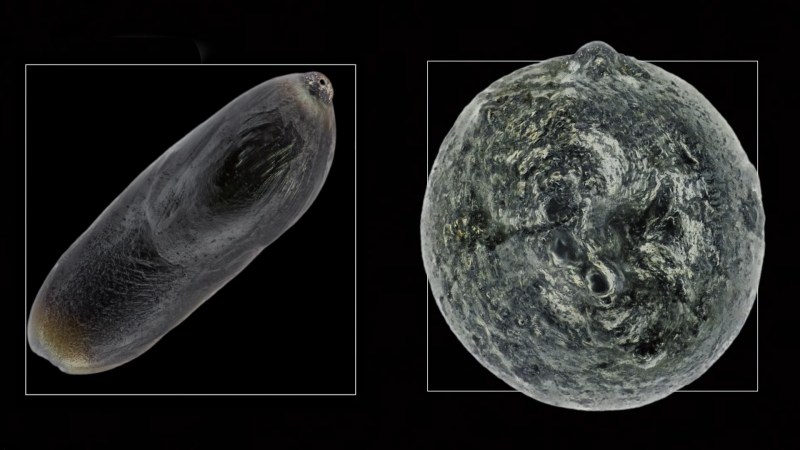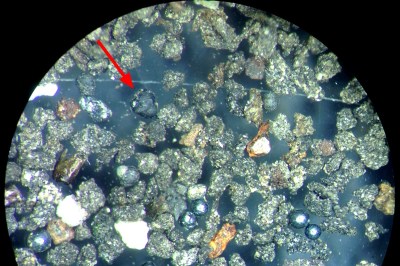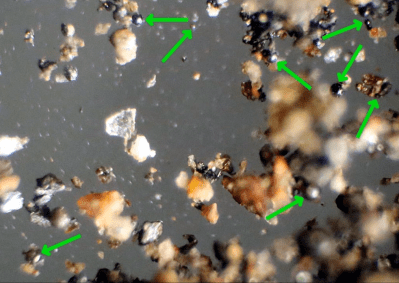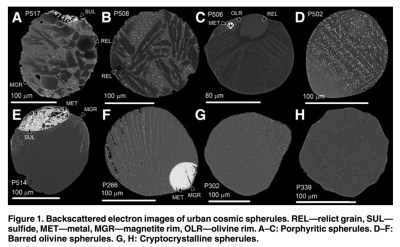Space is very much the final frontier for humanity, at least as far as our current understanding of the universe takes us. Only a handful of countries and corporations on Earth have the hardware to readily get there, and even fewer are capable of reaching orbit. For these reasons, working in this field can seem out of reach for many. Nevertheless, there’s plenty about the great expanse beyond our atmosphere that can be studied by the dedicated citizen scientist. With the right equipment and know-how, it’s even possible to capture and study micrometeorites yourself!

For those new to the field, the terms used can be confusing. Meteoroids are small metallic or rocky objects found in outer space, up to around 1 meter in size. When these burn up upon entering the atmosphere, they are referred to as a meteor, or colloquially known as a shooting star. If part of the object survives long enough to hit the ground, this is referred to as a meteorite, and as you’d expect the smaller ones are called micrometeorites, being on the scale of 2mm or less.
Stardust Proves Hard To Find
Being tiny and having fallen from space, micrometeorites present certain challenges to those who wish to find and identify them. In spite of this, they can be found by using the right techniques and a heck of a lot of hard work.

For a long time, micrometeorites were largely ignored by science due to the perceived difficulty in trying to find them. As Verge Science reports, Jon Larsen took this as a challenge. With an estimated 60-100 metric tons falling to Earth every day, Jon simply refused to believe that nothing could be done. Instead, he took a reverse approach at the problem, becoming an expert on all manner of tiny terrestrial particles. Beginning by collecting particles with a magnet, he would painstakingly sort and identify them. By first identifying all the particles of terrestrial origin, it then became easier to focus on whatever was left over to determine whether or not he had found a micrometeorite.
Jon’s work led to much greater interest in micrometeorites worldwide. Now, A project is underway in Berlin to enlist the services of the citizenry to help find these tiny visitors from outer space (Google Translate link). The methodology used is similar to Jon’s experiments but on a grander scale.
The team placed large tarps on the roofs of university buildings and an Ikea outlet. Dust was allowed to settle on the tarps and over time, 100 kilograms of material was collected. This was sifted to extract only particles under 0.8mm, as in the team’s experience most micrometeorites come in under this size range. This also helps to exclude larger particles from other sources, such as dirt and local air pollution. A magnet is then used to select ferromagnetic particles, and these are then washed and prepared for inspection under the microscope. At the end of sorting, only 15 grams was left over from the initial 100 kilograms collected.

At this point, the citizen scientists come in. There currently is no quick solution to the identification of micrometeorites versus terrestrial dust particles; it simply involves grueling and laborious work by humans to inspect and sort the finds. The participants are trained on what to look for, based on previous finds — primarily not-quite-round, darker objects. Once likely candidates are identified, they are sent off for final geochemical analysis to verify their origin.
Having begun in July, the project aims to eventually display some of the finds in the Museum für Naturkunde Berlin. This promises to be its own challenge, due to the size of the objects in question, but it should make for compelling viewing for anyone wishing to see freshly collected stardust in person.
Taking It DIY: Let the Rain Collect Micrometeorites for You!

Naturally, there’s more than one way to go about collecting micrometeorites. While some projects work by placing collection tarps on large roofs, Wayne Schmidt has a nifty method, placing powerful magnets in the downpipe of his rain gutters. As rain washes collected dust off the roof, magnetic particles stick to the magnets as they pass by, allowing them to be easily collected and put under the microscope. Without university-grade equipment, it’s difficult to 100% classify each particle as a micrometeorite or not, but it’s likely a fair few of the handful Wayne has collected are extraterrestrial in origin.
Rich Lund took a very similar tack, mounting neodymium magnets in a ziplock bag, and placing it in a downpipe. After a rainstorm, the collected matter was scattered on a piece of white paper, and several small metallic spheroid objects are visible. While further analysis is likely needed to prove their definitive origin, it goes to show that it doesn’t take a lot of effort to start investigating this at home.

Papers have even been written on the collection of micrometeorites, long thought impractical due to the presence of heavy particulate pollution and human activity kicking up dirt and dust. For those interested in seeing micrometeorites explored with real hardware, the electron microscope images are a real treat. This kind of muscle is what’s needed to verify finds to a scientifically valid level.
It goes to show that this is a fun way to start looking for space rocks that can be done practically anywhere. Obviously, it doesn’t hurt to make friends with your local university’s geology department if you want to get a definitive answer on your finds, but a microscope and a few magnets is all you need to start hunting. Cast your eyes to the skies, and good luck!

















One thing I’ve wondered about is how much iron could be mined this way. The fact that most of the iron wasn’t from space need not detract.
Well “60-100 metric tons falling to Earth every day”, assuming that is evenly distributed across the planet, and the planet has 510.1 million km² of surface area. You can, in a best case, collect ~0.196 grams of material per day per km² of land you own.
As iron ore sells for $92.63 per ton right now. That would give you an amazing income of $0.00001815548 per day per km², assuming you can collect it for free.
Sounds like you could crowd fund it right now!
Assuming the micrometeorites are 100% iron, and they aren’t. So you can add quite a lot of zeroes after the dot…
Ok, so lets say in your collection (60% as a guess) is iron. What can you imagine the rest as being. I used to work in a mine smelter where the “reverts” the product of the collection and milling was an extremely heavy metallic powder. The composition of this powder was basicly almost every metal, precious or otherwise and was worth thousands of dollars an ounce. If this precursor to “space dust” if you will contained 10% of what generally was in these reverts then yes that might be your value in iron, but let me ask this… what else might you have collected in your samples? Practical? No. But interesting? Yes. I myself live by a beach… I’m going to gather my magnets and see what the lake has been collecting. My guess is due to the weight I might take a few inches off the top of an undisturbed area… just for fun.
I’m not going to say extracting iron from space dust is or isn’t practical. Practicability is depends on the cost of processing. Rural communities are being required to store their sewer system effluent in evaporation ponds. Who knows how many surface acres that will end up being? In the event the collection of space dust is as simple as,using magnets, there may a future where using electromagnet powered by simple and inexpensive wind turbines. I have the Hugh Piggott turbines in mind.
No, assuming “iron ore” and micro meteorites have a similar composition. Iron ore is like 60% iron.
“Assuming the micrometeorites are 100% iron, and they aren’t.”
Right, but they have a high nickel content and some iridium which makes the idea a profitable one! [ just kidding ]
15 grams of iron from 100kilograms of collected dust apparently.
Very interesting!
Statistically, you get hit by at least one micrometeorite per week. Sorry, no source for that as I simply recall it from a report I did long long ago in high school.
That would depend on how much time on spends outdoors There was a time when I would spend as much as 12-16 hours outdoors some days. This article brings to mind many experiments that could by tried.
That probably explains a random stinging sensation while out walking my dog.
I’d have think that would depend on how much time one spends outdoors. There was a time when I’d spend 12-16 hours outdoors, these day far from that.
I wonder if there are enough tagged pictures to train an image classifier.
Could make our own using samples we collect ourselves and any images found? I’m interested in this myself. Would make sorting much easier.
I think the most labor-intensive part would be taking pictures of them under the microscope. They are really tiny…
I like the way you think. Motorized bed running under a microscope, running a CV classifier (and an air jet?) to push them into anoter bin for human identification? This could be a great citizen science hack.
If anyone starts doing this, tips@hackaday.com. :)
I am in for a group/team effort if you guys are. This idea seems to be getting better and better.
The science community would LOVE if we could ID and separate meteorites with a high carbon content.
The larger meteorites with a high quantity of carbon are rare and very valuable to collectors and scientific community.
I can start collecting and if anything, review my samples manually and then send them to the team member who sets up the equipment.
I may attempt this project myself Elliot, just need to check my availability. Am in Russia for another 9 days before returning to the states. I am going to do a collection here. My house here has a plastic roof and no leaves around to clog the gutters.
Did you ever get this going? Am curious to know if you have built a scanning table? AI ?
Please no.
“Are you a human? Select the images which contain micrometeorites”
B^)
I did this almost 30 years ago as a science fair project. My Dad showed me how to collect them using a magnet scouring our gutters and then using a microscope to identify. We had a fist sized meteorite to compare. Found quite a lot after a weeks worth of gutter hunting. Biggest one I found was the size of a pea in my Grandpa’s gutter.
How much magnification do you really need to make the ID? A raspi camera with a macro lense and a ring light… a conveyor belt and something to distribute the particles onto the belt, and some machine learning. Sounds like a seriously fun project.
I think that would be adequate. It was a long time ago but I was using a cheepo microscope at first and then I got bored as it was too much so I started using a strong magnifying glass.
What would be very cool too is if one used your idea to ID carbon meteorites. Those wouldn’t be collected via a magnet though.
Seems a collector lifted to the edge of space with a weather balloon, if they can do it with a lego man why not a micrometeorite collector.
Although you’ll find bigger ones (that haven’t burned up), if your balloon doesn’t get popped (considering the collector would be below the balloon). You’d need a much bigger platform 50Km up compared to the one you’d need at ground level to catch the same amount of area.
Well I was assuming that the balloon would pop but that is a fairly common event with DIY balloons to the edge of space, look at how they recover their payload and copy the best idea. As for needing a big collector, well I was assuming that given the smaller amount of earth dust up high more of your samples would be micrometeorites, even with a smaller collection you would probably average more of the good stuff.
Where the end of the line for micrometeorites is the surface of the Earth why spend money on weather balloons to collect them? Beyond that was sort of collector are you speaking of?Payloads carried by weather balloons have solar panels to help power the payload electronics, any hopefully powering a beacon to assist recovery.
So ~100 tons a day, mostly into the ocean, and some percentage of micrometeorite that makes landfall washes into the oceans along with the typical erosion. Could be some miniscule contribution to sea level rise..